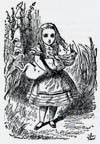
n Wonderland a baby changes into a beast, but in Jane Eyre babies do not become animals, but foreshadow the presence of bestial humans. Jane believes that it is bad luck to dream of infants, and she seems to be right. She dreams, that she, like Alice, is carrying a baby. While the pig-child" . . . was snorting like a steam-engine . . . and kept doubling itself up and straightening itself out again," Jane's phantom 'shivered in my cold arms and wailed piteously in my ear" The outcome for both the babies is the same. They are dropped, Alice's because it has turned into a pig, Jane's because "I was shaken; the child rolled from my knee"
 Alice is finished with her human-animal experience when she drops the baby, but Jane's is just beginning. She wakes to see "A discoloured face - it was a savage face. I wish I could forget the roll of the red eyes and the fearful blackened inflation of the lineaments. This [thing]. . . was purple: the lips were swelled and dark; the brow furrowed; the black eyebrows widely raised over the bloodshot eyes." That is a very non - human description of what turns out to be a woman. A previous week, Jane dreamed of babies for seven nights in a row, at the end of which she found out that John Reed had killed himself and his mother was dying. Carroll and Brontë both make the baby — human — animal connection, but to extremely different ends; Carroll to make fun and entertain, Brontë to convey terror and shock, and hint at the supernatural.
Alice is finished with her human-animal experience when she drops the baby, but Jane's is just beginning. She wakes to see "A discoloured face - it was a savage face. I wish I could forget the roll of the red eyes and the fearful blackened inflation of the lineaments. This [thing]. . . was purple: the lips were swelled and dark; the brow furrowed; the black eyebrows widely raised over the bloodshot eyes." That is a very non - human description of what turns out to be a woman. A previous week, Jane dreamed of babies for seven nights in a row, at the end of which she found out that John Reed had killed himself and his mother was dying. Carroll and Brontë both make the baby — human — animal connection, but to extremely different ends; Carroll to make fun and entertain, Brontë to convey terror and shock, and hint at the supernatural.
Whereas Carroll's treatment of babies in the text hints at his view that they were less adorable and precious than contemporary doctrines might insist, Brontė steers clear of contemporary baby-doctrines altogether by treating babies as less than unimportant. The baby in Jane's dream is by far the most attention - worthy infant in the book - otherwise babies are simply things that various women have, which usually grow into children, and are only then deserving of interest. Except for her dream-children, the most that babies do in Jane Eyre is get put in their beds — "Bessie laid her sleeping child in the cradle." By the time they are three and four they "play[(ed] quietly in a corner," and by the time they reach Adèle's age — seven — they possess characters.
Related Material
Content last modified December 1993